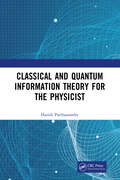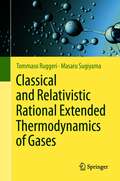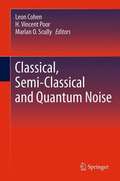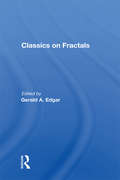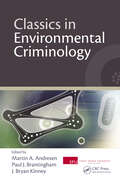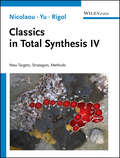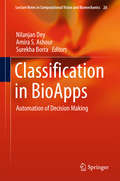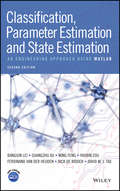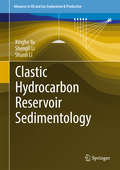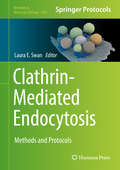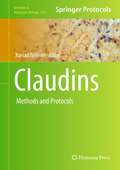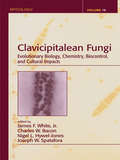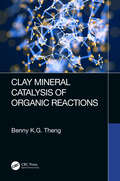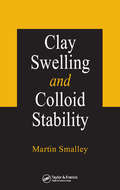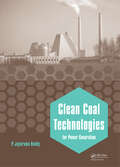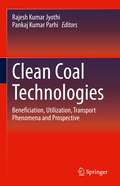- Table View
- List View
Classical and Quantum Dynamics: From Classical Paths to Path Integrals (Graduate Texts in Physics)
by Martin Reuter Walter DittrichGraduate students who want to become familiar with advanced computational strategies in classical and quantum dynamics will find here both the fundamentals of a standard course and a detailed treatment of the time-dependent oscillator, Chern-Simons mechanics, the Maslov anomaly and the Berry phase, to name a few. Well-chosen and detailed examples illustrate the perturbation theory, canonical transformations, the action principle and demonstrate the usage of path integrals. This new edition has been revised and enlarged with chapters on quantum electrodynamics, high energy physics, Green's functions and strong interaction. "This book is a brilliant exposition of dynamical systems covering the essential aspects and written in an elegant manner. The book is written in modern language of mathematics and will ideally cater to the requirements of graduate and first year Ph. D. students. . . a wonderful introduction to any student who wants to do research in any branch of theoretical Physics. " (Indian Journal of Physics)
Classical and Quantum Information Theory
by Emmanuel DesurvireInformation theory lies at the heart of modern technology, underpinning all communications, networking, and data storage systems. This book sets out, for the first time, a complete overview of both classical and quantum information theory. Throughout, the reader is introduced to key results without becoming lost in mathematical details. Opening chapters present the basic concepts and various applications of Shannon's entropy, moving on to the core features of quantum information and quantum computing. Topics such as coding, compression, error-correction, cryptography and channel capacity are covered from classical and quantum viewpoints. Employing an informal yet scientifically accurate approach, Desurvire provides the reader with the knowledge to understand quantum gates and circuits. Highly illustrated, with numerous practical examples and end-of-chapter exercises, this text is ideal for graduate students and researchers in electrical engineering and computer science, and practitioners in the telecommunications industry. Further resources and instructor-only solutions are available at www. cambridge. org/9780521881715.
Classical and Quantum Information Theory for the Physicist
by Harish ParthasarathyThis book deals with certain important problems in Classical and Quantum Information Theory Quantum Information Theory, A Selection of Matrix Inequalities Stochastic Filtering Theory Applied to Electromagnetic Fields and Strings Wigner-distributions in Quantum Mechanics Quantization of Classical Field Theories Statistical Signal Processing Quantum Field Theory, Quantum Statistics, Gravity, Stochastic Fields and Information Problems in Information Theory It will be very helpful for students of Undergraduate and Postgraduate Courses in Electronics, Communication and Signal Processing. Print edition not for sale in South Asia (India, Sri Lanka, Nepal, Bangladesh, Pakistan or Bhutan).
Classical and Quantum Molecular Dynamics in NMR Spectra
by Sławomir Szymański Piotr BernatowiczThe book provides a detailed account of how condensed-phase molecular dynamics are reflected in the line shapes of NMR spectra. The theories establishing connections between random, time-dependent molecular processes and lineshape effects are exposed in depth. Special emphasis is placed on the theoretical aspects, involving in particular intermolecular processes in solution, and molecular symmetry issues. The Liouville super-operator formalism is briefly introduced and used wherever it is beneficial for the transparency of presentation. The proposed formal descriptions of the discussed problems are sufficiently detailed to be implemented on a computer. Practical applications of the theory in solid- and liquid-phase studies are illustrated with appropriate experimental examples, exposing the potential of the lineshape method in elucidating molecular dynamics NMR-observable molecular phenomena where quantization of the spatial nuclear degrees of freedom is crucial are addressed in the last part of the book. As an introduction to this exciting research field, selected aspects of the quantum mechanics of isolated systems undergoing rotational tunnelling are reviewed, together with some basic information about quantum systems interacting with their condensed environment. The quantum theory of rate processes evidenced in the NMR lineshapes of molecular rotors is presented, and illustrated with appropriate experimental examples from both solid- and liquid-phase spectra. In this context, the everlasting problem of the quantum-to-classical transition is discussed at a quantitative level. The book will be suitable for graduate students and new and practising researchers using NMR techniques.
Classical and Quantum Nonlinear Integrable Systems: Theory and Application
by A KunduCovering both classical and quantum models, nonlinear integrable systems are of considerable theoretical and practical interest, with applications over a wide range of topics, including water waves, pin models, nonlinear optics, correlated electron systems, plasma physics, and reaction-diffusion processes. Comprising one part on classical theories
Classical and Relativistic Rational Extended Thermodynamics of Gases
by Tommaso Ruggeri Masaru SugiyamaRational extended thermodynamics (RET) is the theory that is applicable to nonequilibrium phenomena out of local equilibrium. It is expressed by the hyperbolic system of field equations with local constitutive equations and is strictly related to the kinetic theory with the closure method of the hierarchies of moment equations. The book intends to present, in a systematic way, new results obtained by RET of gases in both classical and relativistic cases, and it is a natural continuation of the book "Rational Extended Thermodynamics beyond the Monatomic Gas" by the same authors published in 2015. However, this book addresses much wider topics than those of the previous book. Its contents are as follows: RET of rarefied monatomic gases and of polyatomic gases; a simplified RET theory with 6 fields being valid far from equilibrium; RET where both molecular rotational and vibrational modes exist; mixture of gases with multi-temperature. The theory is applied to several typical topics (sound waves, shock waves, etc.) and is compared with experimental data. From a mathematical point of view, RET can be regarded as a theory of hyperbolic symmetric systems, of which it is possible to conduct a qualitative analysis. The book represents a valuable resource for applied mathematicians, physicists, and engineers, offering powerful models for many potential applications such as reentering satellites into the atmosphere, semiconductors, and nanoscale phenomena.
Classical, Semi-classical and Quantum Noise
by H. Vincent Poor Leon Cohen Marlan O. ScullyDavid Middleton was a towering figure of 20th Century engineering and science and one of the founders of statistical communication theory. During the second World War, the young David Middleton, working with Van Fleck, devised the notion of the matched filter, which is the most basic method used for detecting signals in noise. Over the intervening six decades, the contributions of Middleton have become classics. This collection of essays by leading scientists, engineers and colleagues of David are in his honor and reflect the wide influence that he has had on many fields. Also included is the introduction by Middleton to his forthcoming book, which gives a wonderful view of the field of communication, its history and his own views on the field that he developed over the past 60 years. Focusing on classical noise modeling and applications, Classical, Semi-Classical and Quantum Noise includes coverage of statistical communication theory, non-stationary noise, molecular footprints, noise suppression, Quantum error correction, and other related topics.
Classics On Fractals (Studies In Nonlinearity)
by Gerald A. EdgarRead the masters! Experience has shown that this is good advice for the serious mathematics student. This book contains a selection of the classical mathematical papers related to fractal geometry. For the convenience of the student or scholar wishing to learn about fractal geometry, nineteen of these papers are collected here in one place. Twelve of the nineteen have been translated into English from German, French, or Russian. In many branches of science, the work of previous generations is of interest only for historical reasons. This is much less so in mathematics.1 Modern-day mathematicians can learn (and even find good ideas) by reading the best of the papers of bygone years. In preparing this volume, I was surprised by many of the ideas that come up.
Classics in Environmental Criminology
by Martin A. Andresen J. Bryan Kinney Paul J. BrantinghamA careful analysis of environmental factors is key to understanding the causes of crime, to solving crimes, and eventually helping to predict and prevent them. Classics in Environmental Criminology is a comprehensive collection of seminal pieces from legendary contributors who focus on the role that the immediate environment plays in the occurrence
Classics in Total Synthesis IV: New Targets, Strategies, Methods
by K. C. Nicolaou Ruocheng Yu Stephan RigolFourth volume of a classic in the field of organic synthesis, describing retrosynthetic analysis and total synthesis of important molecules Classics in Total Synthesis IV is a compilation of highly important synthetic methods which lead to complex molecules with valuable properties. From the complex architectures of natural products to the streamlined synthesis of functional molecules, each chapter in Classics in Total Synthesis IV unfolds a unique story. The interplay of mechanisms, reactivity, selectivity, and stereochemical aspects is thoroughly examined, echoing the pedagogical format that has become synonymous with this series. Well-designed graphics are included throughout, and all important parts of the reaction sequences are highlighted. This volume encapsulates the culmination of new methodologies, emerging trends, and a selection of significant total syntheses undertaken from 2009 to 2022 while additionally including two earlier syntheses from 1979 and 1992 for comparison and to highlight the development of organic synthesis over the past decades. The careful balance between historical context, comments on the molecules’ impact to humankind, and the design and execution aspects of each synthesis creates a narrative that is not only clear but also intellectually stimulating. Written by K. C. Nicolaou, Ruocheng Yu and Stephan Rigol, Classics in Total Synthesis IV includes 16 chapters covering: Coupling and rearrangement reactionsRecent advances in nonenzymatic enantioselective cyclizationCycloaddition and annulation reactionsC−H functionalization and transition metal-mediated C−H activationElectroorganic chemistry and visible-light photoredox catalysisHAT-initiated olefin hydrogenation, isomerization, and hydrofunctionalization Joining its predecessors in weaving together the threads of scientific discovery, challenge, and intellectual pursuit and establishing strong connections with biology and medicine, Classics in Total Synthesis IV is an essential reference for all future and present synthetic organic chemists.
Classification Clues
by Catherine StephensIntroduces the basics of classification for plants and animals, with a history of the system devised by Linnaeus, and hands-on exercises in classification.
Classification and Biology
by R.A. CrowsonClassification of plants and animals is of basic interest to biologists in all fields because correct formulation and generalization are based on sound taxonomy. This book by a world authority relates traditional taxonomic studies to developments in biochemical and other fields. It provides guidelines for the integration of modern and traditional methods and explains the underlying principles and philosophy of systematics. The problems of zoological, botanical, and paleontological classifi cation are dealt with in great detail and microbial systematics briefly.
Classification and Examples of Differential Equations and their Applications (Mathematics and Physics for Science and Technology)
by Luis Manuel Braga da Costa CamposClassification and Examples of Differential Equations and their Applications is the sixth book within Ordinary Differential Equations with Applications to Trajectories and Vibrations, Six-volume Set. As a set, they are the fourth volume in the series Mathematics and Physics Applied to Science and Technology. This sixth book consists of one chapter (chapter 10 of the set). It contains 20 examples related to the preceding five books and chapters 1 to 9 of the set. It includes two recollections: the first with a classification of differential equations into 500 standards and the second with a list of 500 applications. The ordinary differential equations are classified in 500 standards concerning methods of solution and related properties, including: (i) linear differential equations with constant or homogeneous coefficients and finite difference equations; (ii) linear and non-linear single differential equations and simultaneous systems; (iii) existence, unicity and other properties; (iv) derivation of general, particular, special, analytic, regular, irregular, and normal integrals; (v) linear differential equations with variable coefficients including known and new special functions. The theory of differential equations is applied to the detailed solution of 500 physical and engineering problems including: (i) one- and multidimensional oscillators, with damping or amplification, with non-resonant or resonant forcing; (ii) single, non-linear, and parametric resonance; (iii) bifurcations and chaotic dynamical systems; (iv) longitudinal and transversal deformations and buckling of bars, beams, and plates; (v) trajectories of particles; (vi) oscillations and waves in non-uniform media, ducts, and wave guides. Provides detailed solution of examples of differential equations of the types covered in tomes l-5 of the set (Ordinary Differential Equations with Applications to Trajectories and Vibrations, Six -volume Set) Includes physical and engineering problems that extend those presented in the tomes 1-6 (Ordinary Differential Equations with Applications to Trajectories and Vibrations, Six-volume Set) Includes a classification of ordinary differential equations and their properties into 500 standards that can serve as a look-up table of methods of solution Covers a recollection of 500 physical and engineering problems and sub-cases that involve the solution of differential equations Presents the problems used as examples including formulation, solution, and interpretation of results
Classification in BioApps: Automation of Decision Making (Lecture Notes in Computational Vision and Biomechanics #26)
by Nilanjan Dey Amira S. Ashour Surekha BorraThis book on classification in biomedical image applications presents original and valuable research work on advances in this field, which covers the taxonomy of both supervised and unsupervised models, standards, algorithms, applications and challenges. Further, the book highlights recent scientific research on artificial neural networks in biomedical applications, addressing the fundamentals of artificial neural networks, support vector machines and other advanced classifiers, as well as their design and optimization. In addition to exploring recent endeavours in the multidisciplinary domain of sensors, the book introduces readers to basic definitions and features, signal filters and processing, biomedical sensors and automation of biomeasurement systems. The target audience includes researchers and students at engineering and medical schools, researchers and engineers in the biomedical industry, medical doctors and healthcare professionals.
Classification, Parameter Estimation and State Estimation: An Engineering Approach Using MATLAB
by Bangjun Lei David M. Tax Dick De Ridder Ferdinand van der Heijden Guangzhu Xu Ming Feng Yaobin ZouA practical introduction to intelligent computer vision theory, design, implementation, and technology The past decade has witnessed epic growth in image processing and intelligent computer vision technology. Advancements in machine learning methods—especially among adaboost varieties and particle filtering methods—have made machine learning in intelligent computer vision more accurate and reliable than ever before. The need for expert coverage of the state of the art in this burgeoning field has never been greater, and this book satisfies that need. Fully updated and extensively revised, this 2nd Edition of the popular guide provides designers, data analysts, researchers and advanced post-graduates with a fundamental yet wholly practical introduction to intelligent computer vision. The authors walk you through the basics of computer vision, past and present, and they explore the more subtle intricacies of intelligent computer vision, with an emphasis on intelligent measurement systems. Using many timely, real-world examples, they explain and vividly demonstrate the latest developments in image and video processing techniques and technologies for machine learning in computer vision systems, including: PRTools5 software for MATLAB—especially the latest representation and generalization software toolbox for PRTools5 Machine learning applications for computer vision, with detailed discussions of contemporary state estimation techniques vs older content of particle filter methods The latest techniques for classification and supervised learning, with an emphasis on Neural Network, Genetic State Estimation and other particle filter and AI state estimation methods All new coverage of the Adaboost and its implementation in PRTools5. A valuable working resource for professionals and an excellent introduction for advanced-level students, this 2nd Edition features a wealth of illustrative examples, ranging from basic techniques to advanced intelligent computer vision system implementations. Additional examples and tutorials, as well as a question and solution forum, can be found on a companion website.
Clastic Hydrocarbon Reservoir Sedimentology (Advances in Oil and Gas Exploration & Production)
by Xinghe Yu Shengli Li Shunli LiThis book presents a comprehensive assessment of clastic sedimentology and its application to reservoir geology. It covers the theoretical foundations of the topic and its use for scientists as well as professionals in the field. Further, it addresses all aspects of reservoir sedimentology, clastic sequence stratigraphy, sedimentation, reservoir diagenesis and heterogeneity, as well as depositional systems (alluvial, fluvial, lacustrine, delta, sandy coast, neritic, deep-water) in detail.The research team responsible for this book has been investigating clastic sedimentology for more than three decades and consists of highly published and cited authors. The Chinese edition of this book has been a great success, and is popular among sedimentologists and petroleum geologists alike.
Clathrate Hydrates of Natural Gases (Chemical Industries)
by E. Dendy Sloan Jr. Carolyn A. KohHydrate research has expanded substantially over the past decade, resulting in more than 4,000 hydrate-related publications. Collating this vast amount of information into one source, Clathrate Hydrates of Natural Gases, Third Edition presents a thoroughly updated, authoritative, and comprehensive description of all major aspects of natural gas cla
Clathrin-Mediated Endoytosis: Methods And Protocols (Methods in Molecular Biology #1847)
by Laura E. SwanThis book presents a methodological introduction on clathrin-mediated endocytosis. Chapters guide readers through a number of model systems, purifications, reconstitutions, analysis techniques and systemic alterations of membrane function, which has been pivotal in understanding the role of clathrin and is panoply of interactors. Written in the highly successful Methods in Molecular Biology series format, chapters include introductions to their respective topics, lists of the necessary materials and reagents, step-by-step, readily reproducible laboratory protocols, and tips on troubleshooting and avoiding known pitfalls. Authoritative and cutting-edge, Clathrin-Mediated Endoytsis: Methods and Protocols aims to ensure successful results in the further study of this vital field.
Claudins: Methods and Protocols (Methods in Molecular Biology #762)
by Kursad TurksenSince the initial discovery of the claudins, the field of tight junctions and cell polarity has become increasingly energized, mainly due to the fact that the claudins have provided an opportunity to understand the molecular basis of the tight junction function and their tissue specific roles. In Claudins: Methods and Protocols, experts and pioneers in the field provide an extensive collection of techniques involving these tight junction proteins. Written in the highly successful Methods in Molecular BiologyTM series format, chapters include brief introductions to their respective topics, detailed lists of the necessary materials and reagents, step-by-step, readily reproducible laboratory protocols, and key tips on troubleshooting and avoiding known pitfalls. Authoritative and practical, Claudins: Methods and Protocols serves as an ideal guide for all scientists seeking to further our understanding of this vital area of research.
Clavicipitalean Fungi: Evolutionary Biology, Chemistry, Biocontrol And Cultural Impacts (Mycology Ser. #Vol. 19)
by James F. White Joseph W. Spatafora Charles W. Bacon Nigel L.Hywel-JonesThis reference analyzes the ecology, evolution, genetics, physiology, and taxonomy of this diverse group of fungi for identification of common biological, biochemical, and genetic features and discovery of potential medical and agricultural applications. It traces and reconstruct the evolution of various host-endoparasite systems and studies recent taxonomic research and DNA sequence analyses on plant-infecting clavicipitaleans. Providing a holistic view of the entire clavicipitalean family, the book compares morphologic, geographic, and host variations among various clavicipitalean populations and examines key discoveries and compounds obtained in clavicipitalean studies.
Clay Mineral Catalysis of Organic Reactions
by Benny K.G. ThengThe book provides insight into the working of clays and clay minerals in speeding up a variety of organic reactions. Clay minerals are known to have a large propensity for taking up organic molecules and can catalyse numerous organic reactions due to fine particle size, extensive surface area, layer structure, and peculiar charge characteristics. They can be used as heterogeneous catalysts and catalyst carriers of organic reactions because they are non-corrosive, easy to separate from the reaction mixture, and reusable. Clays and clay minerals have an advantage over other solid acids as they are abundant, inexpensive, and non-polluting.
Clay Swelling and Colloid Stability
by Martin V. SmalleyIn a rare, over-the-shoulder perspective of a leading scientist's own breakthroughs, Clay Swelling and Colloid Stability puts emphasis on two significant paradigm shifts in colloid science that explain particle interactions for charged plates, stacks, suspensions, and pastes as well as spherical colloids. Martin Smalley first discusses th
Clay's Handbook of Environmental Health
by Stephen BattersbyClay’s Handbook of Environmental Health, since its first publication in 1933, has provided a definitive guide for the environmental health practitioner, or reference for the consultant or student. This 21th edition continues as a first point of reference, reviewing the core principles, techniques and competencies, and then outlining the specialist subjects. It has been refocused on the current curriculum of the UK’s Chartered Institute of Environmental Health but should also readily suit the generalist or specialist working outside the UK.
Clean Coal Technologies for Power Generation
by P. Jayarama ReddyThis book discusses clean coal technology (CCT), the latest generation of coal technology that controls pollutants and performs with improved generating efficiency. CCT involves processes that effectively control emissions and result in highly efficient combustion without significantly contributing to global warming. Basic principles, operational a
Clean Coal Technologies: Beneficiation, Utilization, Transport Phenomena and Prospective
by Rajesh Kumar Jyothi Pankaj Kumar ParhiThis book presents the state of art of the several advanced approaches to beneficiation of coal. The influence of recent technology attains the advantages of processing coal, purification studies, rheological behavior, and the mineral beneficiation. The experts collected in this volume have contributed significantly to the enrichment in the in depth knowledge not only in context of working knowledge, but also future prospects of clean coal technology.


